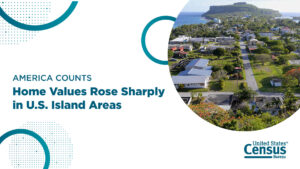WASHINGTON — The U.S. Census Bureau released statistics this week for the U.S. Virgin Islands (USVI) in its 2020 Island Areas Censuses Demographic and Housing Characteristics Summary File (DHC).
The package includes over 400 tables with data on age, race and ethnicity, household type, relationship, population in group quarters, whether the residence is owned or rented (tenure), vacancy status and other social, economic, housing and demographic characteristics. In addition, data are available for island-specific geographies, including islands, subdistricts, estates, towns and census-designated places.
Demographic Characteristics in 2020
- USVI had a population of 87,146, with 42,343 males (48.6%) and 44,803 females (51.4%).
- 21.3% of the population was ages 65 or over and 1.8% was ages 85 or over.
- Children ages 0-17 accounted for 19.6% of the population.
- The median age of USVI’s population was 45.9 years.
Social Characteristics in 2020
- Over two in five (40.1%) households consisted of one person living alone.
- The majority (50.6%) of the 21,759 family households were married-couple families.
- An estimated 3,478 or 8.8% of households had a female householder with no spouse or partner present and children of the householder who were under 18 years old.
- There were 2,452 cohabiting couple households, 6.2% of all households.
- Among family households, 8.6% were multigenerational.
- Nearly three-quarters (73.3%) of women ages 15 and over had ever given birth.
- The median length of marriage for both currently married men and women ages 15 and over in households was 20.3 years.
- Among adults ages 30 and over in households, 4.6% were grandparents who lived with their own grandchildren under 18.
- Of grandparents living in households with their grandchildren under the age of 18, 34.9% were responsible for their basic needs.
- Just under one-half (48.2%) of grandparents caring for grandchildren (under 18) had been responsible for them for 5 years or more.
- Among the population 5 years and older in households who moved between April 1, 2015, and April 1, 2020, 41.4% reported natural disaster as their primary reason for moving.
- Among the population 3 years and over in households, 20.6% were enrolled in school: 7.3% in nursery or preschool; 74.7% in K-12; and 17.9% in college, graduate or professional school.
- Among the population 5 years and over in households, 30.2% spoke a language other than English at home. Of those who spoke a language other than English, 70.3% spoke English “very well” and 56.9% spoke Spanish.
- A majority (78.3%) of the population ages 25 and older in households were high school graduates, and 22.3% had a bachelor’s degree or higher. Business was the most common field of study of those with a bachelor’s degrees
Economic Characteristics in 2019
Note: The Island Areas Censuses asked households about their income the previous year (in 2019).
- Nearly one-quarter (22.8%), or 19,338, of the total 84,766 people in households for whom poverty status is determined had income below the poverty level.
- 18.1% received benefits from the Supplemental Nutrition Assistance Plan (SNAP).
- Median household income decreased from $44,499 (in 2019 inflation-adjusted dollars) in 2009 to $40,408 in 2019.
Housing Characteristics in 2020
- Most (52.2%) occupied units were rented, and 47.8% were owned.
- Median home value was $290,600.
- Median monthly gross rent was $926.
- 19.6% of homeowners and 36.0% of renters spent 35.0% or more of household income on housing costs.
- Among all households, 58.3% had a desktop or laptop computer; 88.6% had a smartphone; and 45.6% had a tablet or other portable wireless device.
- A majority (79.2%) of households had a broadband internet subscription.
A webinar is scheduled today at 5 p.m. ET for those who are interested in accessing the newly released 2020 Island Areas Census DHC data and will focus on leveraging data.census.gov to find available data. Questions related to the data collection process, methodology, disclosure avoidance and data analysis will not be addressed during this session.
Impact of the COVID-19 Pandemic on 2020 Island Areas Censuses
While the 2020 Island Areas Censuses operation was successful, the COVID-19 pandemic impacted the quality of the collected data on detailed social, economic and housing characteristic for American Samoa, Guam and the U.S. Virgin Islands. To ensure the Census Bureau’s high data quality standards are met, adjustments were made to data products reporting population and housing characteristics.
Due to the COVID-19 pandemic impacting data collection efforts for group quarters facilities, U.S. Virgin Islands data tables reporting social and economic characteristics do not include the group quarters population in the table universe. As a result, impacted 2020 data tables should not be compared to 2010 and other past census data tables reporting the same characteristics. The Census Bureau advises data users to verify table universes are the same before comparing data across census years. Additional guidance for data users using the Island Area characteristic data is available in the Guidance on Using Data from the 2020 Island Areas Censuses fact sheet.
About 2020 Island Areas Censuses Data Products for the U.S. Virgin Islands
The 2020 Island Areas Censuses provide a wide range of demographic, social, economic and housing information to meet the U.S. Island Areas’ data needs. Census Bureau surveys, such as the American Community Survey (ACS), are not conducted in the Island Areas. Therefore, the Census Bureau used a long-form census questionnaire similar to the ACS questionnaire used in the 50 states, the District of Columbia and Puerto Rico.
The Census Bureau previously released population and housing counts and a demographic profile for the U.S. Virgin Islands from the 2020 Island Areas Censuses. Later, the Census Bureau also plans to release data tables for the Island Areas that cross tabulate data about people or housing units by other characteristics. More information is available on the 2020 Island Areas Censuses Data Products webpage.

